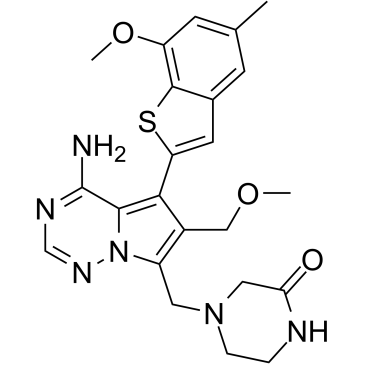| Cas No.: | 1443530-05-9 |
| Chemical Name: | 4-((4-amino-5-(7-methoxy-5-methylbenzo[b]thiophen-2-yl)-6-(methoxymethyl)pyrrolo[2,1-f][1,2,4]triazin-7-yl)methyl)piperazin-2-one |
| Synonyms: | BAY 1163877 |
| SMILES: | CC1=CC2=C(C(=C1)OC)SC(=C2)C3=C4C(=NC=NN4C(=C3COC)CN5CCNC(=O)C5)N |
| Formula: | C23H26N6O3S |
| M.Wt: | 466.56 |
| Purity: | >98% |
| Sotrage: | 2 years -20°C Powder, 2 weeks 4°C in DMSO, 6 months -80°C in DMSO |
| Description: | Rogaratinib is a potent and selective fibroblast growth factor receptor (FGFR) inhibitor. |
| Target: | FGFR1 FGFR2 FGFR3 FGFR4 |
| In Vitro: | Of the 24 cell lines, 2 FGFR1-amplified lung cancer (LC) cell lines, H1581 and DMS114, show extreme sensitivity to Rogaratinib (BAY1163877) (GI50 values ranging from 36 to 244 nM). Treatment with Rogaratinib results in a significant decrease in colonies formed by H1581P cells, but not by H1581AR and BR cells. Ectopic expression of Met significantly induces resistance to Rogaratinib in MTT assays. Met overexpression induces activation of downstream extracellular signal-regulated kinase 1/2 (ERK1/2) and AKT, which cannot be abrogated by Rogaratinib treatment[1]. |
| Cell Assay: | Cells (3000 cells/well) are seeded on 96-well plates at 37°C. After overnight incubation, the cells are treated with Rogaratinib for 72 h. Then, MTT reagent [3-(4,5-Dimethylthiazol-2-yl)-2,5-diphenyltetrazoliumbromide] is added to each well and incubated for 4 h at 37°C. MTT solubilization solution/stop mix is added to each well, mixed, and the plates are incubated overnight at 37°C. After measuring the absorbance at 570 nm, the data are graphically displayed[1]. |
| References: | [1]. Kim SM, et al. Activation of the Met kinase confers acquired drug resistance in FGFR-targeted lung cancer therapy. Oncogenesis. 2016 Jul 18;5(7):e241. |

 To enhance service speed and avoid tariff delays, we've opened a US warehouse. All US orders ship directly from our US facility.
To enhance service speed and avoid tariff delays, we've opened a US warehouse. All US orders ship directly from our US facility.




















